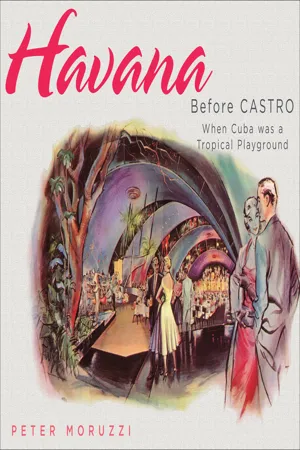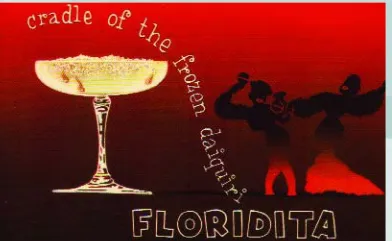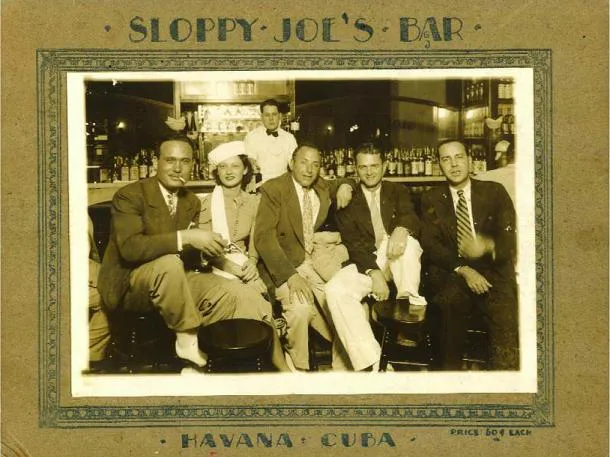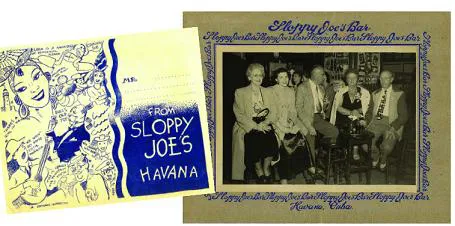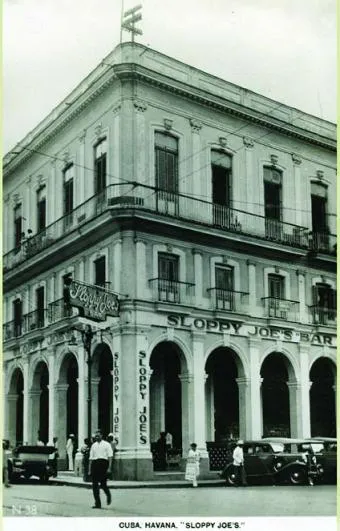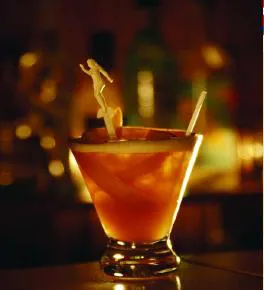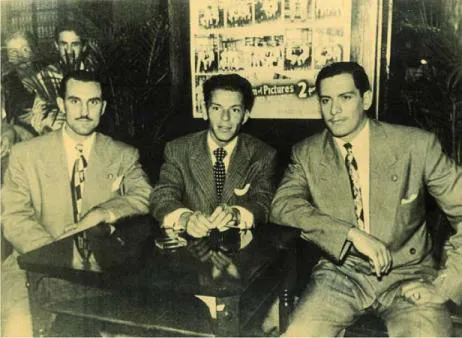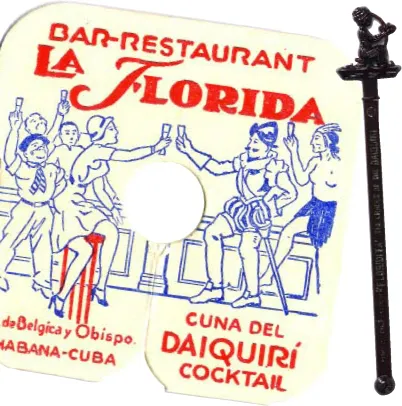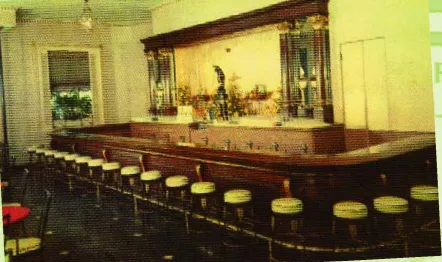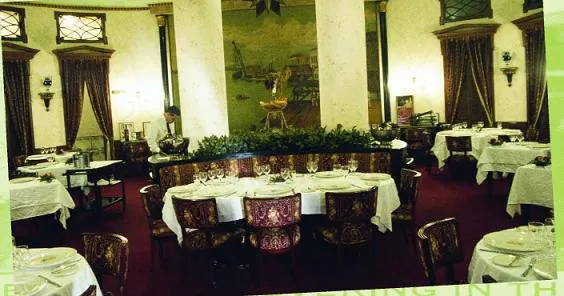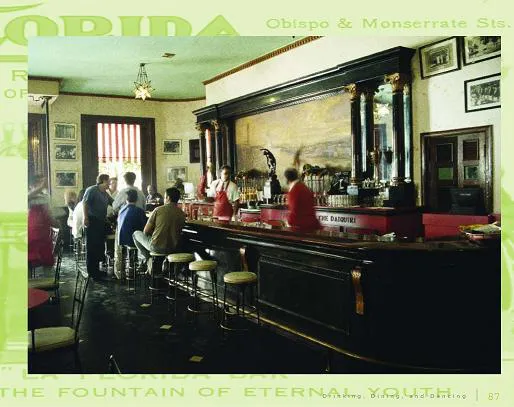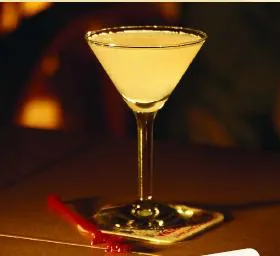![]()
Drinking, Dining, and Dancing
“This is Cuba, Mister.”
—Tropicana comedy revue, 1958
RIGHT:
The dynamic Mary and Rudy dancers “Los Torbellinos del Tropico” (“The Tropical Whirlpool”) perform on a popular Havana television show.
as the nightlife capital of the Caribbean, As the nightlife capital Havana had hundreds of bars, restaurants, and clubs, from seedy dives to fabulous showrooms, all over the city. The most popular nightspots were concentrated near the Prado, central Havana’s promenade, or in the vicinity of Calle 23 (Twenty-Third Street), a sloping thoroughfare known as La Rampa in the city’s sophisticated Vedado district.
Among Havana’s bars, Sloppy Joe’s was in a league all its own, having maintained its reputation as the most popular watering hole for Americans from Prohibition through the Batista years. Havana’s Sloppy Joe’s existed long before the Key West version of the same name. During the 1930s, Sloppy Joe published small pocket-sized cocktail manuals that included a short history of the bar. According to the booklet, José Abeal, a Spanish emigrant who had worked for many years as a bartender in both New Orleans and Havana, converted a small grocery store on the corner of Obispo and Zulueta streets into a saloon in 1918. While several American friends were visiting José “and seeing the poor appearance and filthy-looking condition of the place, one of them said ‘Why, Joe, this place is certainly sloppy, look at the filthy water running from under the counter.’ From here on, the name Sloppy Joe stuck to José Abeal as part of his own life and was destined to make him and his business famous and internationally known.” Curiously, there were other legends regarding the bar’s odd name, including one involving a vindictive
Sloppy Joe’s Then and Now
FACING, LEFT:
Sloppy Joe’s circa 1927.
FACING, RIGHT:
The same view in 2007 during its reconstruction. Sloppy Joe’s closed after suffering a devastating fire in the 1960s.
Sloppy Joe’s
”Sloppy Joe is not Cuba,„ Sydney Clark scolded readers of his 1946 travel guide, All The Best In Cuba. He was bemoaning that most American tourists went straight from their cruise ships to Sloppy Joe’s Bar, and then straight back to their ships. Joe’s was the only thing they saw in Havana, despite the fact that, according to Clark, the bar served ”ordinary drinks in a wholly undistinguished setting.„ Its patrons were 90 percent American tourists, lured to Joe’s by the power of marketing (proprietor José ”Sloppy Joe„ Abeal had been made into a legendary figure by his journalist regulars) and the comfort of the familiar (Cuban citizens dismissed Joe’s as an ”American„ bar). But after obtaining a Sloppy Joe’s recipe booklet dating from the 1935 tourist season, we differ with Sydney Clark on one point: Joe’s drinks were anything but ordinary. In fact, most were quite inventive, such as this 1935 signature drink.
—Jeff Berry
Sloppy Joe’s
2 ounces pineapple juice
1 ounce cognac
1 ounce port wine
1/4 teaspoon orange curaçao
1/4 teaspoon grenadine
Shake well with plenty of crushed ice. Pour into a tall glass. Serve with a straw.
LEFT:
A young Frank Sinatra flanked by mobsters Joe (left) and Rocco Fischetti at Sloppy Joe’s in December 1946. They were in town for the infamous “Havana Summit” of U.S. gangsters presided over by Lucky Luciano at the Hotel Nacional.
FACING:
Outside the Floridita bar and restaurant, Hemingway’s favorite hangout, in 2007.
Havana newspaperman who, having been ejected from the joint by Abeal after refusing to pay his bar tab, retaliated by opining in his column that the bar should be called Sloppy Joe’s on account of its dirty appearance.
Having opened just as Prohibition’s priggish restrictions were shuttering bars from New York to Los Angeles, Sloppy Joe’s welcomed Americans for over four decades with a cocktail menu consisting of over eighty recipes, including the American Girl, Blue Moon, Mary Pickford, Millionaire, Around the World, Miami, Havana, Fox Movietone News [!], and the house drink—Sloppy Joe’s. Like most Havana pubs, Sloppy Joe’s also sold sandwiches, cigars, and bottled booze. Indeed, Sloppy Joe’s bar was stocked to the rafters with display cases containing its own brand of twelve-year-old rum.
After World War II, Sloppy Joe’s original Prohibition-era slogan “First port of call, out where the wet begins” became “Where the great of the world and the not-so-great meet daily.” One of the world’s greats who dropped by was Frank Sinatra during a visit to Havana in December 1946 in the company of his buddies the Fischetti brothers, Joe and Rocco, gangster cousins of Al Capone. Not coincidentally, Ol’ Blue Eyes and the boys were in Cuba for the infamous mafia summit of 1946 held at Havana’s Hotel Nacional, where exiled mob boss Lucky Luciano formally anointed Meyer Lansky as Cuba’s gambling syndicate boss.
Floridita Then and Now
The Floridita
Remarkably, from the furnishings to the place settings, the Floridita hasn’t changed in fifty years, retaining the historic character—and sublime daiquiri cocktails—that Hemingway would recognize if he were alive today.
CLOCKWISE FROM ABOVE:
Floridita dining room circa 1955. The bar circa 1955. The restaurant in 2007.
FACING:
The bar in 2007.
La Floridita Daiquiri
Legend has it that that Jennings Cox, an American engineer working at a Cuban copper mine near the coastal ...
